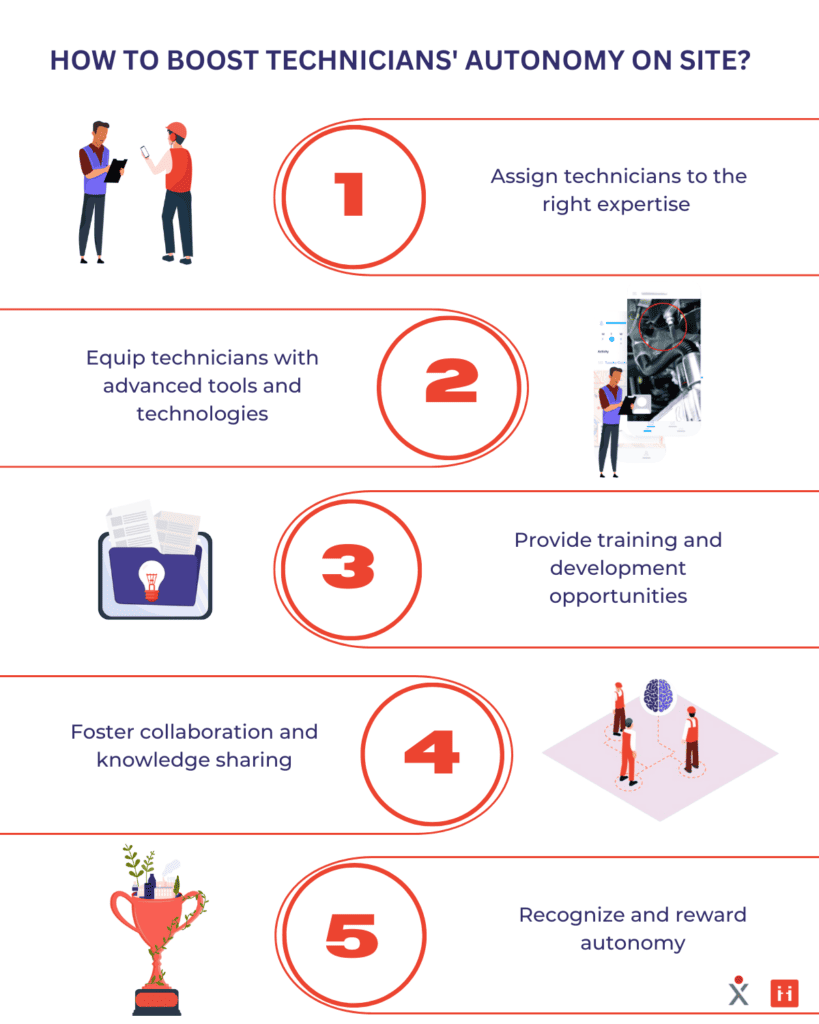
Share this article
Share this article
The technician’s autonomy on-site is a crucial factor that determines the success of performed maintenance activities. They are key figures on-site, therefore it is essential to maximize their efficiency and empower their expertise with advanced tools and organizational practices. The right resources and decision-making authority that makes sure that technicians have a voice can significantly boost their autonomy, job satisfaction, and overall operational performance. In this article, we will go through the best practices that companies can implement to empower their workforce and establish a good working environment on-site.
The technician’s autonomy is directly linked to his/her role because it determines to what extent the technician will be contributing to the team, who he/she reports to, and how he/she interrelates with other team members. It is defined based on the technician’s professional background and aspirations.
Responsibilities are the key tasks that the technician will perform in accordance with the assigned expertise. A clear understanding of his/her profile eliminates the possibility of assigning the technician to tasks that are below his/her competencies or, on the contrary, making him/her responsible for activities out of the scope. Therefore, before assigning the technicians to their expertise it is necessary to list the machines/equipment your company has, what type of assistance and the level of competencies they require, and what measurable and achievable objectives are expected.
By assigning technicians to the right expertise, you facilitate intervention management as in case of a malfunction, the right person will be notified about the needed assistance. This will boost the technician’s confidence in what he/she does and eliminate the wasted time that could be spent on the search for the right professiinal.
Field service management (FSM) solutions powered by remote visual assistance enable a streamlined process of handling interventions. It helps expedite the identification of problems, organization of technicians, and allocation of resources. Technicians’ autonomy increases since they can keep track of their agenda and define their availability and priority tasks, which helps resolve more interventions.
Remote visual assistance embedded into an FSM tool allows robust communication. This facilitates real-time information-sharing among field technicians as well as between experts in the service centers and technicians on site. Everyone has access to the necessary data and can collaborate effectively. Clear and transparent communication leads to improved coordination, reduced errors, and greater autonomy of the employees.
A streamlined process often incorporates data collection, providing valuable insights into intervention patterns and resource utilization. This data can be leveraged for informed decision-making, process optimization, and continuous improvement initiatives such as the creation of learning materials (guides, tutorials, etc.) to boost technicians’ skills.
Technicians’ autonomy is directly linked to the level of competencies they have, therefore, consistent training is essential to develop their technical skills. In the world of rapidly evolving technology, if a technician is not up to date with the advancements, he/she will quickly lose efficiency in the relevant field. Ongoing training ensures that technicians have the necessary expertise to handle complex equipment and emerging technologies, enhancing their technical competence.
Repository based on the data generated during interventions using field service management solution with remote visual assistance results in saved costs on internal training.
It is also a matter of safety. Field service technicians often work with equipment or in environments that pose potential safety risks. Training programs focus on safety protocols, best practices, and compliance requirements. By receiving proper training, technicians can mitigate risks, protect themselves and others, and ensure adherence to relevant safety standards and regulations.
Sometimes the encountered problems can be too complex or unique and require additional expertise. With the right tools such as remote visual assistance, the technician can trigger a real-time video call, so his/her colleagues could get a 360° view of the problem and assist with the resolution. Moreover, if the team members can have access to the interventions, they can collaborate asynchronously by sharing feedback and attaching relevant files with no limit in size via video reports. Such collaborative approach not only helps solve problems faster and more efficiently but also elevates the overall team spirit.
With the help of video recordings of the interventions, technicians can share the best practices which creates an environment of growth and continuous learning.
The field service management tools with such knowledge management capabilities boost technicians’ autonomy because they know who they can contact if needed and what resources can help them.
Technicians working on-site know the equipment/machines they are dealing with like no one else. Adopting the bottom-up approach when technicians’ feedback is the foundation for informed decisions concerning interventions. This approach stimulates participation and shows employees that their voice is needed and they are heard.
When technicians have the freedom to make decisions and take responsibility for their actions, they feel trusted and valued by the company. This autonomy fosters a sense of pride in their work and motivates them to perform at their best.

In summary, recognizing and rewarding the autonomy of field technicians empowers them, enhances their problem-solving capabilities, promotes flexibility and adaptability, supports continuous learning and growth, increases job satisfaction, and enhances overall efficiency and effectiveness. By acknowledging and valuing their autonomy, organizations can create a positive work environment that maximizes the potential of their field service team.